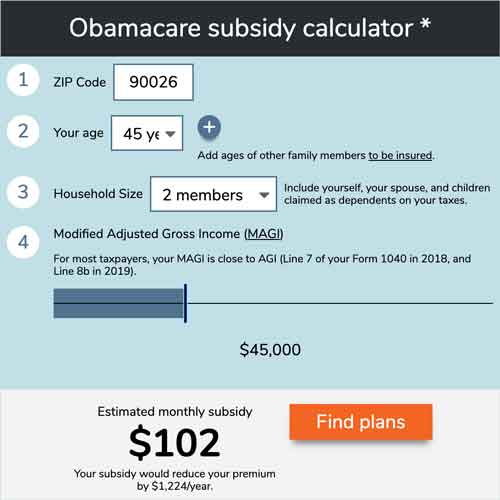Thanks to the Affordable Care Act (ACA, also known as Obamacare), there are high-quality, comprehensive health insurance plans available in every state for people who need to purchase their own health insurance.
Obamacare subsidy calculator *
Estimated annual subsidy
$0
But differentiating between ACA-compliant plans and lesser-quality options can be harder than it might sound, especially since there are non-ACA-compliant plans that are often marketed in ways that make it challenging to tell that they don’t provide the same level of coverage as an ACA-compliant plan.
Where can I buy an ACA-compliant health plan?
For starters, there are numerous sources of ACA-compliant individual-market plans:
- In each state there’s one exchange/marketplace website (HealthCare.gov in 33 states; a state-run exchange site in 17 states and DC). The government sites all have “see plans and prices” tools that enable you to determine whether you’re eligible for government help to pay premiums and possibly reduce out-of-pocket costs. If you are eligible, you should either enroll via the federal or state exchange or make sure that any broker you work with shows you all ACA-compliant plans to which your subsidy applies.
- Numerous insurers and web brokers are approved enhanced direct enrollment entities and can help consumers enroll in on-exchange plans via their own websites.
- Brokers and navigators certified by the exchanges in each state help consumers through the process of enrolling in a plan through the exchange. (This tool on HealthCare.gov can help you find assistance in your area. The state-run exchanges have similar tools.) These professionals should also help you determine whether you’re subsidy-eligible before showing plans and quoting prices.
- And then there are also fully ACA-compliant plans sold outside the exchanges (everywhere except DC), purchased directly from the insurer or with the help of an agent or broker. These are often referred to as “off-exchange” options.
Before shopping anywhere outside the government exchanges, you need to determine whether you are likely eligible for government help paying for coverage. If you are, it’s essential that you avoid off-exchange plans, as you’ll forfeit your financial assistance if you don’t buy coverage through the exchange.
You can use our tool to quickly and anonymously see if you might be eligible for a subsidy. And if you haven’t checked in a while, it’s important to check again: The American Rescue Plan has increased the size of premium subsidies and made them more widely available by eliminating the “subsidy cliff” as of 2021. And the Inflation Reduction Act has extended those subsidy enhancements through 2025. So even if you didn’t qualify for a subsidy in the past, you might qualify now.
But in addition to those options, there are a great number of other plans available that don’t conform to the ACA’s rules. Some aren’t even regulated as insurance at all (eg, healthcare sharing ministry plans, direct primary care plans, and Farm Bureau plans in some states).
How can I spot a plan disguised as ACA-compliant health insurance?
Some plans can be very cleverly disguised to look as if they’re compliant with the ACA. They might be described with terms like “Gold” or “Silver” (which are used for ACA-compliant plans to differentiate the level of coverage provided by the plans). They might be marketed with urgent-sounding messages about open enrollment deadlines, when in fact, these non-compliant plans tend to be available for purchase year-round.
And they’re quite likely to show up when you search online for “Obamacare plans” or “health insurance” or something similar. They may also be labeled as “Trumpcare,” despite the fact that there’s no such thing — GOP-backed legislation to repeal and replace the ACA never came to fruition.
People who enroll in these plans may not realize that they’ve got sub-par coverage until they end up needing significant medical care. But by then it’s too late.
Ask these questions to ensure you’re buying real ACA coverage

Use our calculator to estimate how much you could save on your ACA-compliant health insurance premiums.
Here are five questions you can ask when you’re trying to determine whether a health plan is compliant with the ACA, and whether it will actually be there for you when the chips are down:
1. “Does this plan require any sort of medical underwriting? Will my health history be taken into consideration either during the application process, or after I’m enrolled and have a claim?”
- If access to a plan depends on your medical history, the plan is not ACA-compliant.
- If premiums are based on anything other than your age, zip code, and tobacco use, the plan is not ACA-compliant.
But a few points to keep in mind about this:
- A thorough broker helping you enroll in an ACA-compliant plan will still ask you questions about which doctors you see and any prescription drugs you take. This has nothing to do with medical underwriting; it’s because each plan has different provider networks and covered drug lists, and you want to make sure the one you pick will cover your doctor and your medications. The federal and state exchanges also have DIY plan selection tools that ask questions about your doctors and prescriptions to help you choose a plan.
- Although premiums are only based on age, location, and tobacco use, there are other factors – such as your income and whether you have access to an employer-sponsored plan – that will be taken into consideration if you want to apply for a premium subsidy. (Most consumers who shop in the exchange end up qualifying for subsidies. You can use our anonymous tool to quickly see if you might be eligible for a subsidy.)
2. “Will pre-existing conditions be covered as soon as the policy takes effect?”
If the answer is no, the plan is not compliant with the ACA.
3. “Is this plan guaranteed renewable as long as I continue to pay the premiums? Or, if the insurer stops offering this plan, is a switch to a comparable plan guaranteed as long as I continue to pay the premiums?”
If the answer is no, the plan is not compliant with the ACA.
4. “Does this plan cover maternity care, prescription drugs (including specialty drugs), and mental health care?”
If the answer is no, the plan is not compliant with the ACA. Maternity care, prescriptions, and mental health care are all among the essential health benefits (EHBs) that all ACA-compliant individual (and small-group) plans are required to cover. But if you just ask whether the plan covers essential health benefits, the salesperson might say “yes” because the plan covers other EHBs. Maternity care, high-cost prescriptions, and mental health care are some of the EHBs that are most frequently lacking on non-ACA-compliant plans.
5. “Does this plan absolutely cap my out-of-pocket costs for medically necessary care as long as I stay in-network?”
- If the answer is no, the plan is not compliant with the ACA. All ACA-compliant plans are required to cap in-network out-of-pocket costs for essential health benefits at no more than $9,100 for a single individual in 2023 (this upper limit is inflation-adjusted each year).
- This question helps to identify fixed indemnity plans, which are not regulated by the ACA. Fixed indemnity plans cap the benefits as opposed to capping your out-of-pocket exposure. In the event of a serious medical condition, that can end up being a significant problem.
- A non-compliant plan may claim to have a cap on out-of-pocket costs. If that plan has no network, however – if it boasts that it’s good with any provider – that means that hospitals and doctors have not agreed to accept the insurer’s payment as full payment. In that case, you will likely be subject to balance billing, meaning that hospitals or doctors may bill you for the difference between what the plan pays them and what they think they should be paid. ACA-compliant plans have provider networks, and as long as you only use providers within the network (and meet any prior authorization requirements), your out-of-pocket costs will be capped and you won’t be responsible for additional balance billing.
- Starting in 2022, the federal government imposed new rules to prevent “surprise” balance billing, protecting consumers in emergencies and when out-of-network providers perform services at in-network facilities. But these protections do not apply to plans that aren’t ACA-compliant, such as short-term plans or fixed indemnity plans.
Louise Norris is an individual health insurance broker who has been writing about health insurance and health reform since 2006. She has written dozens of opinions and educational pieces about the Affordable Care Act for healthinsurance.org.








